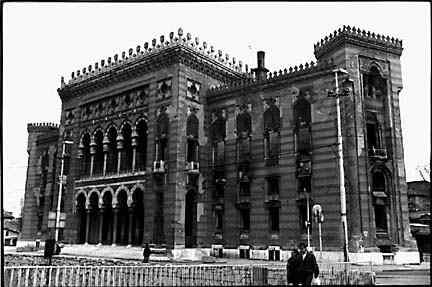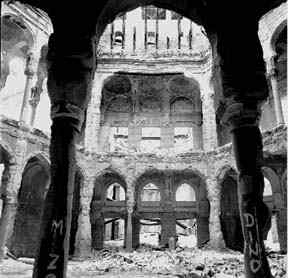




 |
 |
 |
 |
 |
|
| Contents Forward Backwards |
|
Genocide is often assumed to mean the mass destruction of a people. That certainly was happening throughout Bosnia during most of the war, but according to the Genocide Convention, the term also refers to the intentional destruction of culture. The National Library in Sarajevo is one of the most well-known buildings in Sarajevo. Built by the Austro-Hungarian administration in 1896 in a Moorish Revival style, it has been used as the seat of the Austro-Hungarian administration, the Bosnian parliament building, the Sarajevo Town Hall, and finally the National and University Library. In addition to housing the 1.5-million-volume National and University Library, it also held over 155,000 rare books and manuscripts and the country's national archives. The building is situated on the banks of the Miljacka River facing the Serb-controlled hills to the south. The building was an easy target and massively assaulted by incendiary bombs in August 1992. While the building was awash in flames, some brave librarians and residents of Sarajevo attempted to save what they could, but most of the contents were quickly destroyed in a tremendous conflagration. Sarajevans said that for days afterward it rained ashes from the burned books and manuscripts. Three months earlier, the nearby Oriental Institute, housing the largest collection of Islamic and Jewish manuscript texts and Ottoman documents in southeastern Europe, suffered a similar fate. The books can perhaps be replaced someday, but the fire destroyed forever priceless and irreplaceable manuscripts and records from the Ottoman period. This alone would constitute genocide under international law. Andras Riedlmayer, bibliographer in Islamic Art and Architecture, the Aga Khan Program for Islamic Architecture, contributed to the above piece. |
  |